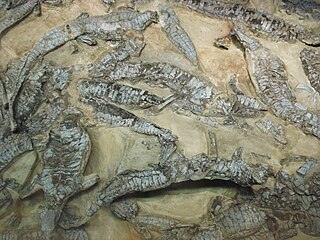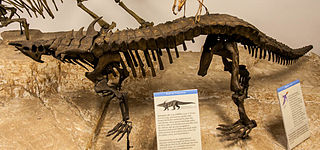
Aetosaurs are heavily armored reptiles belonging to the extinct order Aetosauria. They were medium- to large-sized omnivorous or herbivorous pseudosuchians, part of the branch of archosaurs more closely related to crocodilians than to birds and other dinosaurs. All known aetosaurs are restricted to the Late Triassic, and in some strata from this time they are among the most abundant fossil vertebrates. They have small heads, upturned snouts, erect limbs, and a body ornamented with four rows of plate-like osteoderms. Aetosaur fossil remains are known from Europe, North and South America, parts of Africa, and India. Since their armoured plates are often preserved and are abundant in certain localities, aetosaurs serve as important Late Triassic tetrapod index fossils. Many aetosaurs had wide geographic ranges, but their stratigraphic ranges were relatively short. Therefore, the presence of particular aetosaurs can accurately date a site in which they are found.

Aetosaurus is an extinct genus of pseudosuchian reptile belonging to the order Aetosauria. It is generally considered to be the most primitive aetosaur. Three species are currently recognized: A. ferratus, the type species from Germany and Italy; A. crassicauda from Germany; and A. arcuatus from eastern North America. Additional specimens referred to Aetosaurus have been found in the Chinle Group of the southwestern United States, and the Fleming Fjord Formation of Greenland. Specimens of Aetosaurus occur in Norian-age strata.

Desmatosuchus is an extinct genus of archosaur belonging to the Order Aetosauria. It lived during the Late Triassic.
Calyptosuchus is an extinct genus of aetosaur from the Late Triassic of North America. Like other aetosaurs, it was heavily armored and had a pig-like snout used to uproot plants.

Acaenasuchus is an extinct genus of pseudosuchian, endemic to what would be presently be known as Arizona during the Late Triassic, specifically during the Carnian and Norian stages of the Triassic. Acaenasuchus had a stratigraphic range of approximately 11.5 million years. Acaenasuchus is further categorized as one of the type fauna that belong to the Adamanian LVF, based on the fauna of the Blue Mesa Member of the Chinle Petrified Forest Formation of Arizona, where Acaenasuchus was initially discovered.

Aetosauroides is an extinct genus of aetosaur from the Late Triassic of South America. It is one of four aetosaurs known from South America, the others being Neoaetosauroides, Chilenosuchus and Aetobarbakinoides. Three species have been named: the type species A. scagliai, A. subsulcatus and A. inhamandensis. Fossils have been found in the Cancha de Bochas Member of the Ischigualasto Formation in the Ischigualasto-Villa Unión Basin in northwestern Argentina and the Santa Maria Formation in the Paraná Basin in southeastern Brazil. The strata date to the late Carnian and early Norian stages, making Aetosauroides one of the oldest aetosaurs.
Lucasuchus is an extinct genus of aetosaur. Fossils have been found from the Bull Canyon Formation of the Dockum Group outcropping in the Revuelto Creek locality in Quay County, New Mexico. All specimens date back to the Norian stage of the Late Triassic. The genus was named in 1995 after the American paleontologist Spencer G. Lucas.

Paratypothorax is an extinct genus of aetosaur, known from a single species, Paratypothorax andressorum. It was a broadly distributed member of the group found in Germany, North America, and possibly parts of Gondwana. The best specimens come from Germany, though for more than a century they were mistakenly considered phytosaur armor. Paratypothorax was a large and wide-bodied typothoracine aetosaur, as well as the namesake of the tribe Paratypothoracisini.
Tecovasuchus is an extinct genus of aetosaur. It is known primarily from osteoderms found from the Tecovas Formation in Texas, which is Late Triassic in age, dating back to the lower Norian. Material is also known from several other localities of the Chinle Group in New Mexico and Arizona, such as older Carnian outcrops and younger Rhaetian outcrops. Specimens of Tecovasuchus have been collected from the Tecovas Formation, the Bluewater Creek Formation, and the Los Esteros Member of the Santa Rosa Formation.

Typothoracinae is a clade of aetosaurs within the subfamily Aetosaurinae. It was originally defined as a stem-based taxon including all aetosaurs closer to Typothorax than to Stagonolepis or Desmatosuchus. This definition was later expanded to specifically exclude Aetosaurus; as of 2016, Typothoracinae is defined as the least inclusive clade containing Typothorax and Paratypothorax, but not Aetosaurus,Stagonolepis, or Desmatosuchus. The clade was first named in 2007 under the spelling Typothoracisinae, after its namesake Typothorax. However, this spelling was based on incorrect taxonomic nomenclature, and the clade's name was corrected to Typothoracinae in 2016.

Aetosaurinae is one of the two main clades of aetosaurs, the other being Desmatosuchia. It is a stem-based taxon defined as all aetosaurs more closely related to Aetosaurus than Desmatosuchus. Aetosaurinae currently comprises Aetosaurus, similar forms such as Coahomasuchus and Stenomyti, and the widespread and successful aetosaur clade Typothoracinae.

Paratypothoracini is a clade of aetosaurs within the group Typothoracinae. It is a node-based taxon that includes Rioarribasuchus (=Heliocanthus), Paratypothorax, Tecovasuchus, and all descendants of their most recent common ancestor. The clade was first named in 2007 under the spelling Paraypothoracisini, after its namesake Paratypothorax. However, this spelling was based on incorrect taxonomic nomenclature, and the clade's name was corrected to Paratypothoracinae in 2016.

Desmatosuchinae is a major subfamily of aetosaurs within the clade Desmatosuchia. It is a stem-based taxon defined as all aetosaurs more closely related to Desmatosuchus than to Stagonolepis,Aetosaurus, or Paratypothorax.
Redondasuchus is an extinct genus of aetosaur. It may be a junior synonym of Typothorax coccinarum, another aetosaur. Redondasuchus is a member of the clade Typothoracisinae within the subfamily Aetosaurinae, and lived during the middle Norian stage of the Late Triassic. Material belonging to the genus has been found from the Redonda Formation in east-central New Mexico. The type species, R. reseri, was named in 1991 after having been referred to as a species of Typothorax since 1985. A second species, R. rineharti, was described in 2006.
Aetobarbakinoides is an extinct genus of stagonolepidid aetosaur known from the Late Triassic of Rio Grande do Sul state, southern Brazil. Fossils have been found from the Santa Maria Supersequence of the late Carnian and early Norian stages, making Aetobarbakinoides one of the oldest aetosaurs. The type species, A. brasiliensis, was named in 2012, and is notable for being described primarily by features of the vertebrae; most other aetosaurs are diagnosed by features in bony plates called osteoderms, which are by far the most common material. Although placed in a basal phylogenetic position among aetosaurs, Aetobarbakinoides is closely related to both desmatosuchines and typothoracisines, two derived clades of aetosaurs.
Gorgetosuchus is an extinct genus of aetosaur from the Late Triassic of the North Carolina, represented by the type species Gorgetosuchus pekinensis. It is mainly known from osteoderms, including the front half of an articulated carapace. Gorgotesuchus is typically considered a basal desmatosuchin, though alternative interpretations exist.

Scutarx is an extinct genus of Aetosauriformes, most commonly regarded by its species name Scutarx deltatylus. Scutarx lived around 230 million years ago during the Carnian and Norian stage of the Late Triassic. Scutarx are “medium sized” paramedian osteoderms belonging to the clade Aetosauria, a heavily armored and more herbivorous cousin of crocodiles.
Apachesuchus is an extinct genus of aetosaur from the Late Triassic of New Mexico. It is only known from several paramedian osteoderms discovered in Quay County in eastern New Mexico. This area belongs to the late Norian-age Quay Member of the Redonda Formation. Unique among aetosaurs, its osteoderms are nearly completely smooth, without strong pits or grooves. The left dorsal paramedian has a relatively high width-to-length ration, suggesting that Apachesuchus is a wide-bodied aetosaur within the clade Typothoracinae.
Kryphioparma is an extinct genus of aetosaur from the Late Triassic Blue Mesa Member of the Chinle Formation, Arizona. It is the oldest known member of the subfamily Typothoracinae, and is currently only known from five isolated and incomplete dorsal osteoderms. Regardless, said osteoderms show a clear mix of features that do not match any other known aetosaur and were thus used as the basis for a new genus and species in 2023. The genus is monotypic, only including a single species, Kryphioparma caerula.
Garzapelta is an extinct genus of aetosaur from the Late Triassic Cooper Canyon Formation containing a single species, G. muelleri. Garzapelta is known primarily from an associated collection of osteoderms, although some other bones such as ribs are also known. The anatomy of Garzapelta's armour displays a mix of features otherwise seen in Rioarribasuchus chamaensis, a member of the Paratypothoracini, and taxa of the subfamily Desmatosuchinae. This mix of characters is so distinct that phylogenetic analysis yielded different results based on what parts of the osteoderms were used, suggesting that the current dataset does not account for convergent evolution in osteoderm anatomy. Reyes, Martz and Small suggest that Garzapelta was likely a paratypothoracin that simply evolved lateral osteoderms similar to those of desmatosuchins, reasoning that its armour does not articulate in the way seen in members of the latter group.












